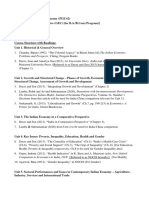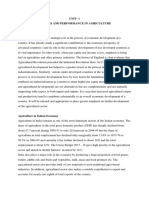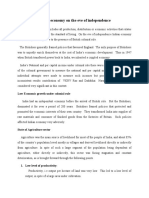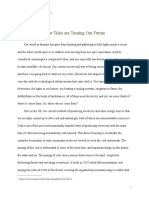Indian Economy Notes
Indian Economy Notes
Uploaded by
Abhishek VermaCopyright:
Available Formats
Indian Economy Notes
Indian Economy Notes
Uploaded by
Abhishek VermaCopyright
Available Formats
Share this document
Did you find this document useful?
Is this content inappropriate?
Copyright:
Available Formats
Indian Economy Notes
Indian Economy Notes
Uploaded by
Abhishek VermaCopyright:
Available Formats
UNIT-1 An economy- Introduction Economy an introduction Economic growth and development Determinants of economic development Factors affecting economic
ic development Features of the Indian economy Concepts of human development Essential components of human development Importance and need of human development INTRODUCTION -ECONOMY Let us begin with the word 'economy'. It denotes the operations and management of the economic system - the activities related to production of goods and services, consumption, investment, exchange of goods and services within the geographical territory, and exports and imports with rest of the world. You may have observed that production of goods and services requires inputs such as labor, capital (machineries, buildings, etc.) and raw materials. The inputs are available in limited quantity, i.e., there is a shortage of inputs. When these inputs are used in the production process, they need to be paid some reward. For example, if you want to employ a unit of labor you have to pay some wage to him or her. Similarly, building can be hired by paying some rent or money can be borrowed by paying some interest. Ultimately utilization of inputs involves some costs. Thus the objective before the economy is to utilize the scarce resources efficiently so that production of goods and services is maximized and cost is minimized. INDIAN ECONOMYThe term Indian economy is the outcome of two words, Indian plus economy.Indian refers to those concerning India. Economy refers to all those activities and arrangements which the citizens of a country, either individually or collectively, undertake to satisfy their wants of food, clothing, shelter, etc. Indian economy is not just a study of facts and figures relating to economic life of India rather it undertakes to analyze the causes and effects of the problems pertaining to economic life. Nature of Indian economy becomes clear from the following characteristics: 1- Indian economy is an underdeveloped economy 2- Indian economy is a mixed economy 3- Indian economy is a planned developing economy 1-Indian economy is an underdeveloped economyPer capita income of some countries of the world like America, England, Japan etc. is much higher than that of some other countries like India, Pakistan, Sri Lanka, Bangladesh, etc. economies of the former countries are called developed economies. On the other hand, there
are countries like India, Bangladesh, Pakistan etc whose per capita income is much less than that of the developed ones. Economies if such countries are called underdeveloped economies. Economic Growth is a narrower concept than economic development. It is an increase in a country's real level of national output which can be caused by an increase in the quality of resources (by education etc.), increase in the quantity of resources & improvements in technology or in another way an increase in the value of goods and services produced by every sector of the economy. Economic Growth can be measured by an increase in a country's GDP (gross domestic product). Economic development is a normative concept i.e. it applies in the context of people's sense of morality (right and wrong, good and bad). The definition of economic development given by Michael Todaro is an increase in living standards, improvement in self-esteem needs and freedom from oppression as well as a greater choice. The most accurate method of measuring development is the Human Development Index which takes into account the literacy rates & life expectancy which affects productivity and could lead to Economic Growth. It also leads to the creation of more opportunities in the sectors of education, healthcare, employment and the conservation of the environment. It implies an increase in the per capita income of every citizen. The economic level of a country is the single most important environmental element to which the foreign marketer task. The stage of economic growth within a country affects the attitudes toward foreign business activity, the demand for goods, the distribution systems found within a country, and the entire marketing process. In static economies consumption patterns become rigid and marketing is typically nothing more than a supply effort. In a dynamic economy, consumption patterns change rapidly. Marketing is constantly faced with the challenge of detecting and providing for new levels of consumption and marketing efforts must be matched with ever changing market needs and wants. Economic development presents a two sided challenge. First, a study of the general aspects of economic development is necessary to gain empathy regarding the economic climate within developing countries. Second, the state of economic development must be studied with respect to market potential, including the present economic level and the companys growth potential. The current level of economic development dictates the kind and degree of market potential that exists, while knowledge of the dynamism of the economy allows the marketer to prepare for economic shifts and emerging markets. Economic development is generally understood to mean an increase in national production that result in an increase in the average per capita gross domestic product (GDP). Besides an increase in average per capita GDP most interpretations of the concept also imply a widespread distribution of the increased income. Economic development, as commonly defined today, tends to mean rapid economic growth and increases in consumer demand improvements achieved in decades rather than centuries.
GROWTH AND DEVELOPMENT: A CONTRAST IN CONCEPTS
Economic development is a broader term than economic growth Economic growth usually means the growth in production of an economy. On the other hand, Economic development includes other factors such as literacy health, child mortality Rate, equality, regional balance, infrastructure, etc. Let us take the example of a child. As a child grows her weight and height increases. Simultaneously, her capacity to learn, recognize and distinguish between objects develops. Thus growth is not sufficient; we need development also. Similarly, in the case of the Indian economy economic growth is not enough; we need economic development. We need better health of people, education for all, reduction in inequality among sections of people and regions, reduction in infant mortality rate (IMR), access to drinking water for all, etc. The government has to devise policies and allocate government expenditure so that these facilities are available to all. Thus the additional income generated in the economy reaches the backward regions and the poorer sections of society. To achieve economic development we need economic growth. In a stagnant economy, where there is no economic growth, realization of economic development is difficult. Economic growth refers to increase over time in a countrys real output of goods and services or more appropriately production per capita .The economic development ,in contrast is more comprehensive. It implies progressive changes in the socio-economic structure of a country. Viewed in this way economic development involves a steady decline in agricultures share in GNP and a corresponding increase in the share of industries, trade, banking, construction and services. Thus the economic growth signifies only the rise in real national income and per capita income whereas, the Term economic development signifies the rise in real national income and per capita incomes along with the following structural changes in the economy1-Changing occupational structure: The process of economic development is accompanied by the flight of labor from primary to secondary and tertiary sectors. 2-Changing sectoral structure of national income: In the course of economic development, the relative contributions of secondary and tertiary sectors in the generation of rise in national income. 3-Changing structure of industrial production: The process of economic development involves industrialization .according to Haffman, as the economy develops the ratio of production of capital goods to consumer goods rises. 4-Changing structure of foreign trade: The development process leads to increasing consumption of raw-material in the growing manufacturing industries. 5-Technological progress and innovations: The traditional techniques of productions gradually give way to science based highly automated techniques .The increasing proportion of GNP is devoted to R&D.
DETERMINANTS OF ECONOMIC DEVELOPMENT The process of economic development is a highly complex phenomenon and is influenced by numerous and varied factors such as political, social and cultural factors. According to prof.R. NurkseEconomic development has much to do with human endowments, social
attitudes, political condition and historical accidents .capital is necessary but not a sufficient condition of progress. The supply of natural resources, the growth of scientific and technological knowledge etc. have a strong bearing on the process of economic growth. 1. Economic determinants: The three most important factors determining the rate of economic development are: a- Capital formation b- Capital output ratio c- The rate of population growth a) Capital formation: Capital accumulation is the very core of economic development. It is quite necessary to step up the rate of capital formation so that the community accumulates a large stock of machines, tools, and equipment which can be geared into production. The process of building up the necessary stock of capital equipments requires huge resources for financing it. Either a large part of national income must be saved for production of capital goods or the necessary funds for the purpose may be borrowed from abroad. b) Capital output ratio: The term capital output ratio refers to the number of units of capital that are required in order to produce one unit of output. It is difficult to estimate the capital output ratio for an economy. the productivity of capital depends upon many factors such as degree of technological development associated with capital investment, the efficiency of handling new types of equipments ,the quality of managerial and organizational skills, the pattern of investment and the existence and the extend of the utilization of economic overheads. c) Rate of population growth: Rapid growth of population is considered to be important determinants of growth. In terms of per capita income, on account of rise in population, the country experiences a very thin spread of the benefits of growth. This highlights the need or a large and active programmed of family limitation so that the benefits of the massive development are not dissipated. 2. Non-economic determinants a-social and cultural factors B-political factors C-adverse international efforts a) Social and cultural factors: These factors are no less important and are very extensive in scope. Each society has certain institutions which have a strong bearing an economic development. In India for Example , the institutions of caste, joint families , non-materialistic attitude of the people , and their fatalism based on the philosophy of karma have been some of the serious impediments to economic development .naturally the various relevant social and cultural factors will have to be suitably adopted before the tempo of economic development can be expected to quicken. b) Political factors: In addition to the economic and social factors there are also the political factors which retard economic growth .For example during the British regime, the government
promoted British interests at the expenses of Indian interests .After independence two things did not improve dishonest and corruption. Favoritism, nepotism, and corruption were rampant all over the country. The people too lacked sense of the duty and devotion to the country and were trying to enrich themselves at the expense of the country. c) Adverse international factors: Economic relations with the advanced countries have also kept the under-developed countries in a state of under development. Developing countries are not exposed to the beneficial effects of foreign trade in terms of economic development. Developing countries are often exposed to the cyclical effects of foreign trade which results in instability and impede economic growth. FACTORS AFFECTING ECONOMIC DEVELPOMENT It depends on two sets of factors economic and non-economic. A) Economic factors in economic development 1. Capital formation: It is now universally admitted that a country which wants to accelerate the pace of growth, has no choice but to save a high ratio of its income with the objective of raising the level of investment. Economists rightly assert that due to lack of capital formation no development plan will succeed unless adequate supply of capital is forthcoming. 2. Marketable surplus of agriculture: Increase in agricultural production accompanied by a rise in its productivity is important from the point of view of the development of a country, with the development of an economy, the ratio of the urban population increases and increasing demands are made agriculture for food grains. These demands must be met adequately; otherwise the consequent scarcity of food in urban areas will arrest growth. 3. Conditions in foreign trade: Foreign trade has proved to be beneficial to countries which have been able to set up industries in a relatively short period. These countries sooner or later capture international markets for their industrial products. Therefore the developing country should attempt to push the development of its industries to such a high level that in the course of the time manufactured goods replace the primary products of the country principal exports. 4. Economic system: The economic system and the historical settings of a country also decide the developmental prospects to a great extent. There was a time when a country could have a laizse faire economy and yet face no difficulty in making economic progress .the third world countries of the present times will have to find their own path of development only by adopting capitalism or socialism. B) Non-economic factors in economic development 1. Human resources: Economist often see population as an obstacle to growth rather than as a factor which assist the developmental activity .nevertheless, man makes positive contribution to growth. Man provides labor is efficient and skilled; its capacity to contribute to economic growth will decidedly be high.
2. Technical knowledge: As the scientific and technological knowledge advances, man discovers more sophisticated techniques of production which steadily raise the productivity levels. If a country in modern times neglects this activity, it will have to pay a heavy price in terms of industrial under development. 3.Political freedom: We all know that the under development of India ,Pakistan, Bangladesh, Sri Lanka and a few other countries, which were in the past British colonies, was linked with the development of England . England recklessly exploited them and appropriated a large portion of the economic surplus. This made a significant contribution to Britishs economic development .hence political freedom is an essential condition for the economic development of a country. 4. Social organization: Under the circumstance, it is futile to hope that masses will participate in the development projects undertaken by the state. 5. Corruption: Until and unless there countries root out corruption in their administrative system, it is most natural that the capitalists, traders, and powerful economic classes will continue to exploit natural resources in their personal interests. 6. Desire to develop: The pace of economic growth in any country depends to a great extend on peoples desire to develop. If in some country level of growth consciousness is low and the general mass of people has accepted poverty as its fate, then there will be little hope for development of the nation. FEATURES OF THE INDLAN ECONOMY At the time of Independence the Indian economy was stagnant and highly underdeveloped. Agriculture was the backbone of the economy but agricultural activities were undertaken through obsolete technology. Industrial sector contributed very little to gross domestic product (GDP). In order to give a direction to the economy the government initiated economic panning in the form of Five Year Plans in 1951. Over the years the economy has witnessed increase in GDP, the composition of GDP has changed, standard of living of people has improved, and there has been up gradation in level of technology. The important features of the Indian economy are as follows: 1. Low per capita income: Under developed economy is characterized by low per capital income. India per capital income is very low as compared to the advanced countries. For example the capital income of India was 460 dollar, in 2000. Whereas their capita income of U.S.A in 2000 was 83 times than India. This trend of difference of per capita income between under developed and advanced countries is gradually increasing in present times. India not only the per capita income is low but also the income is unequally distributed. This mal-distribution of income and wealth makes the problem of poverty and stands an obstacle in the process of economic progress. 2. Heavy Population Pressure:
The Indian economy is facing the problem population explosion. It is clearly evident from the total population of India which was 102.67 cores in 2001 census. It is the second highest populated country China being the first. Indias population has reached 110 cores. All the under developed countries are characterized by high birth rate which stimulates the growth of population; the fast rate of growth of population necessitates a higher rate of economic growth to maintain the same standard of living. The failure to sustain the living standard makes the poor and under developed countries poor and under developed. 3. Excessive dependence on Agriculture: Occupational distribution of population in India clearly reflects the backwardness of the economy. One of the basis characteristics of an under developed economy is that agriculture contributes a very large portion in the national income and a very high proportion of working population is engaged in agriculture 4. Unemployment: There is larger unemployed and under employment is another important feature of Indian economy by which India suffers a lot. In dec,2009 the number of unemployed,registered in 969 employment exchanges of the country were 3.82 crore. On account of employment ,there is wastage of labor power ,less production ,low per capita income and low rate of investment. 5. Low Rate of Capital Formation: In backward economics like India, the rate of capital formation is also low. Capital formation mainly depends on the ability and willingness of the people save since the per capita income is low and there is mal-distribution of income and wealth the ability of the people to save is very low in under developed countries for which capital formation is very low . 6. Poor Technology: The level of technology is a common factor in under developed economy. India economy also suffers from this typical feature of technological backwardness. The techniques applied in agriculture industries milling and other economic fields are primitive in nature. 7. Back wards Institutional and social frame work: The social and institutional frame work in under developed countries like India is hopelessly backward, which is a strong obstacle to any change in the form of production. Moreover religious institutions such as caste system, joint family universal marriage affects the economic life of the people. 8. Under utilization of Resources: India is a poor land. So our people remain economically backwards for the lack of utilization of resources of the country.
9. Price instability: Price instability is also a basis feature of Indian economy. In almost all the underdeveloped countries like India there is continuous price instability. Shortage of essential commodities and gap between consumption and productions increase the price persistently. Rising trend of price creates a problem to maintain standard of living of the common people. 10. The Indian economy is a developing economy. It has not yet reached the level of economic development seen in America and Europe. 11) The Indian economy is a mixed economy in the sense that both private sector and public sector coexist and participate in the production process. 12) It is characteristized by high population density and population growth. 13) About one-third of the population live below poverty line. 14) The level of technology used in production process is low in many sectors. Modern technology has not been adopted in all sectors of the economy. 15) There is a shortage of physical and economic infrastructure. Transportation (roads, Railways, airlines), power (electricity, gas), and communication (telephone, Internet) have not reached all parts of the country. Even some parts of the country do not have provisions for schools, colleges, hospitals and safe drinking-water Supply. 16) Indian economy is basically an agricultural economy. More than 60% of the population is engaged in agriculture and allied (related) activities. 17) Low per capita income is also one of the features of Indian economy. It is one of the lowest in the world. 18) The occupational structure has not been changed during the last 100 years. In 1950-51 about 73% of the workers were engaged in primary activities, 11% in secondary and 16% in tertiary activities. In 1999-2000 the share of different sectors in employment amounted to 60%, 17% and 23% respectively. 19) Inequality of income and wealth is other important feature of Indian economy. 20) There has been remarkable improvement in social sectors such as education, health, housing, water supply, etc. 21) Planning process is also an important feature. As the government has adopted planned developmental economy. Five years plans are framed for economic development. CONCEPT OF HUMAN DEVELOPMENT Human capital refers to stock of skill and expertise of a nation at a point of time. Human capital formation is the process of adding to stock of human capital through creation of skilled ,trained and efficient labor force by providing better education, healthcare facilities, etc. thus it is a process of providing education, healthcare, nutrition, and training facilities, to the labor force so
that they can handle the sophisticated (high technology) capital equipments efficiently and can innovate ideas and methods of production through their enhanced knowledge .more human capital formation means increase in production capacity of the economy as a whole. Increase in production capacity implies higher levels of output, growth and development.
ESSENTIAL COMPONENTS OF HUMAN DEVELPOMENT There are four basic pillars of human development: equity, sustainability, production and empowerment. Equity is the idea of fairness for every person; we each have the right to an education and health care. Secondly, sustainability is the view that we all have the right to earn a living that can sustain us and have access to a more even distribution of goods amongst populations. In addition, production is used to show how the government needs more efficient social programs for its people. Lastly, empowerment is an effect of general well-being.[
Importance of human development/need
Human development can take place through education, health and family welfare. It also influenced by political, social and legal environments in the society. Humandevelopment is very much required for economic, social and cultural developments in society. The need and importance of human development is briefly explained as follows 1. Increases Efficiency of People: Human development involves availability of better' health and educational facilities. This facilitates better development of skills, improvement in health standards. Better skills and better health standards help improve the overall efficiency and productivity of the people in the society. 2. Facilitates Research & Development (R&D): Human development induces R&D activities in the society. This is because; human development creates a pool scientists and technicians, who research into new applications, which can be use for further developments in the field of science and technology. Apart from science and technological development, research is also conducted in economic and social areas, which in turn can facilitate economic and social development in the country 3. Control of Population. Human development involves education on the part of the people. Literacy makes people aware of the negative consequences of large families. ln lndia, one of the main causes of high population is the low literacy rate, especially among females, and that too, in highly populated states of Rajasthan, UP, and Bihar Literate people can control population through effective population control measures. 4. Social Order: Human development improves quality of life of the people. It makes people better citizens, and as such people may not get involved into anti-social
activities like civil riots, social and religious conflicts, robberies, and so on. This would help to maintain social order in the society. This is because; educated people are less prone to anti-social activities as compared to less or illiterate people, who can be easily misguided by religious fundamentalists and other anti-social elements. 5. Concern for Environment: Human development makes people to have concern' for environment. Educated people understand the negative consequences of polluting the environment, and as such they may adopt environmental protection measures. However, illiterate persons may be ignorant of the consequences of environmental degradation and as such they may not take adequate measures to protect environment, and at the same time, their actions may negatively affect the environment. 6. Equity: Human development ensures the concept of equity. Equity is one of the essential components of human development. The people who enjoy high levels of human development are conscious of the principle of equity or social justice. These people help to create an environment for equitable access to opportunities in the field of education, business, and other activities. 7. Empowerment.' Human development facilitates the concept of empowerment in societies or countries, which enjoy high levels of human development, there is empowerment of men and women so that they can compete equally. People in developed nations have the freedom to exercise their choices. 8. Economic Development: Human development helps to develop productivity of the people in all the sectors of the economy. Higher efficiency on the part of people helps to develop better techniques of production and marketing of goods and services. This in turn facilitates economic growth of the country.
You might also like
- Indian Economy in The Eve of Independence - Question BankDocument4 pagesIndian Economy in The Eve of Independence - Question BankHari prakarsh Nimi100% (1)
- The Indian Economy Sem VIDocument2 pagesThe Indian Economy Sem VIWaseem SiddiquiNo ratings yet
- Bs RP TrivediDocument194 pagesBs RP TrivediSrikrishna Shelly60% (5)
- Electronic Principles and Circuits Lab Manual - BEC303 - 18-11-2023Document69 pagesElectronic Principles and Circuits Lab Manual - BEC303 - 18-11-2023Maithira H50% (2)
- (Indian Economy - 2) UNIT - 1 POLICIES AND PERFORMANCE IN AGRICULTUREDocument31 pages(Indian Economy - 2) UNIT - 1 POLICIES AND PERFORMANCE IN AGRICULTUREAndroid Boy75% (8)
- National Income and Occupational Structure in IndiaDocument45 pagesNational Income and Occupational Structure in IndiaakshatNo ratings yet
- (Indian Economy - 2) UNIT - 2 POLICIES AND PERFORMANCE IN INDUSTRYDocument16 pages(Indian Economy - 2) UNIT - 2 POLICIES AND PERFORMANCE IN INDUSTRYAndroid Boy100% (2)
- An Uncertain Glory Chapter 3Document6 pagesAn Uncertain Glory Chapter 3manik100% (3)
- Keynesian Theory of Income and EmploymentDocument3 pagesKeynesian Theory of Income and EmploymentDimple Pankaj Desai89% (9)
- Ch-1 Indian Economy in The Eve of Independance (Choice Based Questions)Document9 pagesCh-1 Indian Economy in The Eve of Independance (Choice Based Questions)social sites100% (2)
- Banking & Finacial Institution UGC NET - COMMERCEDocument15 pagesBanking & Finacial Institution UGC NET - COMMERCEamit kumar shukla100% (1)
- UGC NET - Marketing ManagementDocument85 pagesUGC NET - Marketing ManagementKasiraman Ramanujam100% (1)
- Relative Income HypothesisDocument13 pagesRelative Income HypothesisTaruna Bajaj100% (2)
- 12 Economics - Liberalisation, Privatisation and Globalisation An Appraisal - Notes and Video LinkDocument14 pages12 Economics - Liberalisation, Privatisation and Globalisation An Appraisal - Notes and Video Linksayooj tvNo ratings yet
- Theories of Development and Indian Economy PDFDocument119 pagesTheories of Development and Indian Economy PDFSudhanshu Bele100% (4)
- Hspice Simulation of Nand and InverterDocument16 pagesHspice Simulation of Nand and InverterNidhi SolankiNo ratings yet
- Indian Economy Notes BookDocument80 pagesIndian Economy Notes BookAasif Nengroo100% (1)
- Indian Economy Lecture Notes Unit IDocument5 pagesIndian Economy Lecture Notes Unit IAmit Kumar86% (7)
- What Are The Basic Characteristics of Indian EconomyDocument5 pagesWhat Are The Basic Characteristics of Indian EconomyHarshit dua67% (3)
- Economic Environment in India (B.com) P-2Document115 pagesEconomic Environment in India (B.com) P-2Anonymous uHT7dDNo ratings yet
- What Are The Basic Characteristics of Indian EconomyDocument2 pagesWhat Are The Basic Characteristics of Indian Economy2912manisha100% (3)
- Role of Advertising in Indian EconomyDocument13 pagesRole of Advertising in Indian EconomyTashi GuptaNo ratings yet
- The Role of Industrialization in The Economic Development of IndiaDocument7 pagesThe Role of Industrialization in The Economic Development of IndiaHarshit duaNo ratings yet
- Industrial Development in IndiaDocument17 pagesIndustrial Development in IndiaSiddharth VermaNo ratings yet
- Ch-1 Indian Economy in The Eve of Independance (True or False)Document3 pagesCh-1 Indian Economy in The Eve of Independance (True or False)social sitesNo ratings yet
- Economic Growth and DevelopmentDocument17 pagesEconomic Growth and DevelopmentSachin Methree100% (1)
- Industrial Development During Planning Period Indian EconomyDocument27 pagesIndustrial Development During Planning Period Indian EconomyFarah Shaheryar100% (2)
- XI Economics Class Notes by Ca Parag Gupta: (RKG Institute)Document92 pagesXI Economics Class Notes by Ca Parag Gupta: (RKG Institute)xenxhuNo ratings yet
- National Income MBADocument54 pagesNational Income MBABabasab Patil (Karrisatte)100% (5)
- Human Capital FormationDocument14 pagesHuman Capital FormationKaustubh Chintalapudi100% (1)
- Indian Economy On The Eve of IndependenceDocument12 pagesIndian Economy On The Eve of IndependenceHarini BNo ratings yet
- Gandhi.s Preparation For England Q & ADocument3 pagesGandhi.s Preparation For England Q & ANO ONE100% (1)
- Class 12 Economic - Indian Economic Development NCERT Solution eDocument115 pagesClass 12 Economic - Indian Economic Development NCERT Solution eRounak BasuNo ratings yet
- PubFin - Principle of Maximum Social AdvantageDocument15 pagesPubFin - Principle of Maximum Social AdvantageWasif Mohammad100% (2)
- Importance of Small Scale Industries in Indian EconomyDocument2 pagesImportance of Small Scale Industries in Indian EconomySandeep100% (1)
- 11 Economics Statistics For Economics Introduction Notes and VideoDocument5 pages11 Economics Statistics For Economics Introduction Notes and VideoOs Da100% (2)
- Poverty in IndiaDocument20 pagesPoverty in IndiaMukul Bajaj100% (2)
- 2 Central Problems of An EconomyDocument5 pages2 Central Problems of An Economysoundarya raghuwanshi100% (1)
- Impact of Multinational Corporations On Indian Economy'Document23 pagesImpact of Multinational Corporations On Indian Economy'Aishani Chakraborty0% (1)
- Indian Economy 1950-1990Document63 pagesIndian Economy 1950-1990social sites100% (1)
- The Role of The Public Sector Enterprises in The Indian EconomyDocument6 pagesThe Role of The Public Sector Enterprises in The Indian Economysrikanth_ravindra0% (1)
- Indian Economy 1950-1990 - Question BankDocument5 pagesIndian Economy 1950-1990 - Question BankHari prakarsh Nimi100% (3)
- Corruption in Public LifeDocument3 pagesCorruption in Public Lifevijeyeraj0% (1)
- Bent Hansen's Excess Demand ModelDocument13 pagesBent Hansen's Excess Demand ModeluzmaNo ratings yet
- Nelson's Low Level Equilibrium TrapDocument3 pagesNelson's Low Level Equilibrium TrapKris Sara Sajiv100% (2)
- Indian Economy-Pre Independace Perion (Sandeep Garg)Document13 pagesIndian Economy-Pre Independace Perion (Sandeep Garg)parthNo ratings yet
- Income TaxDocument124 pagesIncome Taxsannu91100% (2)
- CBSE Class 12 Economics Full Study MaterialDocument85 pagesCBSE Class 12 Economics Full Study Materialsakshamkohli97No ratings yet
- Indian Economy (Assertion and Reasoning)Document3 pagesIndian Economy (Assertion and Reasoning)Shivam Mutkule0% (1)
- Role of Public & Private Sector in IndiaDocument13 pagesRole of Public & Private Sector in IndiaAppan Kandala Vasudevachary50% (2)
- Ch.4 - Measurement of National Income ( (Macro Economics - 12th Class) ) Green BookDocument120 pagesCh.4 - Measurement of National Income ( (Macro Economics - 12th Class) ) Green BookMayank Mall0% (1)
- Indian Economic Development Notes and Q/A BookletDocument72 pagesIndian Economic Development Notes and Q/A BookletKashvi ChakrawalNo ratings yet
- Assertion Reason Questions For Chapter - 1, 2 and 3 of Indian Economy DevelopmentDocument41 pagesAssertion Reason Questions For Chapter - 1, 2 and 3 of Indian Economy DevelopmentGauravNo ratings yet
- Fiscal Policy in IndiaDocument41 pagesFiscal Policy in IndiaNeeraj Kumar100% (3)
- Economics Project 2021-22 - Tarun Robins Xii C 3Document37 pagesEconomics Project 2021-22 - Tarun Robins Xii C 3Skottayy100% (2)
- Subhash Dey's IED Textbook 2024-25 Sample PDFDocument46 pagesSubhash Dey's IED Textbook 2024-25 Sample PDFravinderd2003No ratings yet
- Project On CitizenshipDocument13 pagesProject On Citizenshipkulwinderkaur100% (3)
- Accounting For GSTDocument30 pagesAccounting For GSTHarnitNo ratings yet
- Indiference Curve Analysis, PPTDocument14 pagesIndiference Curve Analysis, PPTsabyasachi8460% (5)
- Ch.1 Indian EconomyDocument26 pagesCh.1 Indian Economyrudayesh.ambulkar703No ratings yet
- Lecture Notes1, Factors For Eco Dev. (Dr. Atiq)Document10 pagesLecture Notes1, Factors For Eco Dev. (Dr. Atiq)Eamon awanNo ratings yet
- Ocr On A Grid Infrastructure: Project SynopsisDocument9 pagesOcr On A Grid Infrastructure: Project SynopsisAbhishek VermaNo ratings yet
- Subject CodeDocument2 pagesSubject CodeAbhishek VermaNo ratings yet
- Liberalization: Globalization Globalization Refers To The Increasing Unification of The World'sDocument4 pagesLiberalization: Globalization Globalization Refers To The Increasing Unification of The World'sAbhishek VermaNo ratings yet
- TTL-Transistor - Transistor Logic Transistor-Transistor Logic, or TTL, Refers To The Technology For Designing and FabricatingDocument3 pagesTTL-Transistor - Transistor Logic Transistor-Transistor Logic, or TTL, Refers To The Technology For Designing and FabricatingAbhishek VermaNo ratings yet
- Fourth Generation Mobile TechnologyDocument28 pagesFourth Generation Mobile TechnologyAbhishek VermaNo ratings yet
- Chapter 11 HandoutDocument20 pagesChapter 11 HandoutJenecelle Cabanag EnciertoNo ratings yet
- Military + Aerospace Electronics - October 2023Document56 pagesMilitary + Aerospace Electronics - October 2023Mansoor ShahNo ratings yet
- O General Duct Unit Inverter 2022Document2 pagesO General Duct Unit Inverter 2022Mohd TabishNo ratings yet
- Work Breakdown StructureDocument13 pagesWork Breakdown StructureBridget Smith100% (3)
- REPORTDocument19 pagesREPORTHabirah Mahmood MutanganaNo ratings yet
- Lost! - BB Tenor Sax (Marching Band) - Print Sheet Music NowDocument1 pageLost! - BB Tenor Sax (Marching Band) - Print Sheet Music NowEdward GonzalezNo ratings yet
- Economic Models:: Basic Mathematical Tools Applied in EconomicsDocument28 pagesEconomic Models:: Basic Mathematical Tools Applied in EconomicsGaurav AroraNo ratings yet
- 11.04 Iso-6272-2-2011Document9 pages11.04 Iso-6272-2-2011hoanvuNo ratings yet
- MFS)Document47 pagesMFS)SanthiyaNo ratings yet
- Approved - Guidance: GNB-CPDDocument23 pagesApproved - Guidance: GNB-CPDHelloKids Poppins100% (1)
- CPG 101Document172 pagesCPG 101Doc LumpkinsNo ratings yet
- Final Project Report 1Document99 pagesFinal Project Report 1Sikander GirgoukarNo ratings yet
- A Leader Leads by Example NewDocument6 pagesA Leader Leads by Example NeweuniczelNo ratings yet
- Chapter 1. Advanced DigitalDocument36 pagesChapter 1. Advanced DigitalÃmânî TëfëNo ratings yet
- Happiness Is Like A HugDocument26 pagesHappiness Is Like A HugSrinivas KalaNo ratings yet
- Ayurveda Lucella CjenikDocument1 pageAyurveda Lucella CjenikHrvatski strelicarski savezNo ratings yet
- FCC Regulations Part 97 PDFDocument2 pagesFCC Regulations Part 97 PDFChristopherNo ratings yet
- Stuff 2Document2 pagesStuff 2PA PlantNo ratings yet
- To Kenya Examination CouncilDocument1 pageTo Kenya Examination CouncilMIghty SaitamaNo ratings yet
- Housing Society Project by 12 StudentDocument20 pagesHousing Society Project by 12 StudentAryan MehteleNo ratings yet
- HR Interview QuestionsDocument8 pagesHR Interview Questionskoti7575No ratings yet
- Module 1 (Learning Assessment)Document5 pagesModule 1 (Learning Assessment)Filipino 1 Maedelyn De GuzmanNo ratings yet
- Probability and Random Processes 4th Edition Geoffrey R. Grimmett Download PDFDocument66 pagesProbability and Random Processes 4th Edition Geoffrey R. Grimmett Download PDFvinterdyrvig100% (2)
- Tidal Energy EssayDocument5 pagesTidal Energy EssayDessie AliNo ratings yet
- Pro 404Document1 pagePro 404Luis MontañezNo ratings yet
- 01-SAMMS-046 Stainless PipeDocument11 pages01-SAMMS-046 Stainless PipesureshNo ratings yet
- SJ-20100726164139-001-ZXDU58 S151 (V4.1R01M01) DC Power System Installation Manual - 280793Document59 pagesSJ-20100726164139-001-ZXDU58 S151 (V4.1R01M01) DC Power System Installation Manual - 280793Abdennour Bouras100% (2)
- BiophilicApproachtoArchitectureCaseoftheAlhambraal Andalus PDFDocument177 pagesBiophilicApproachtoArchitectureCaseoftheAlhambraal Andalus PDFVijaya LakshmiNo ratings yet






























































































